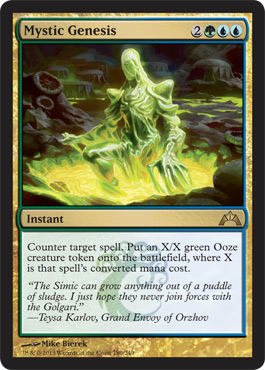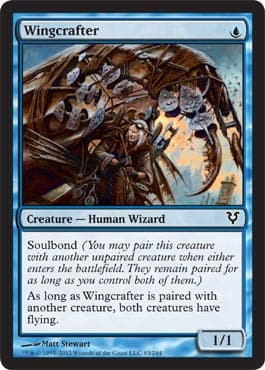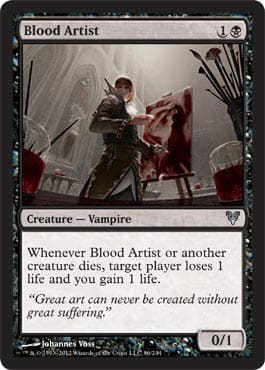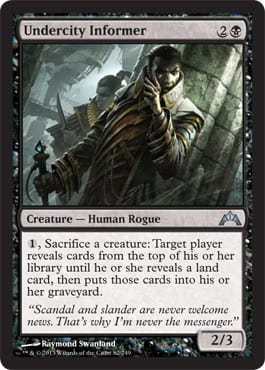What if I told you there was a deck that could gain infinite life, generate infinite mana, and deck your opponent all in one turn? Would that pique your interest?
And what if I said you could line up your Blood Crypts and Isolated Chapels in a deck other than The Aristocrats? Might that get your attention, super-narrow niche of Oros fans?
With quite a bit of time under our belt in Internet years since the results of Pro Tour: Gatecrash (one Internet year is roughly equal to .87 seconds, or however long it takes for the second person to type “First” in the comments section of an article), the Top 8 decks and the most-played archetypes have surely been examined, analyzed, reconfigured, and FNM’d to death. You’ve probably faced some or all of the Top 8 lists online or in local tournaments multiple times by now.
But ever since the Pro Tour went to a fully split format with both Limited and Constructed portions of the event feeding into players’ eventual finishes, there’s been a tendency for a number of perfectly viable innovations to be looked over simply because their pilots didn’t do quite as well in the Limited portion.
So today, I’m going to go over a whopping ten decks from Pro Tour: Gatecrash that all went at least 6–4 in the Constructed portion of the event. They all got little to no press during the event (hey, we can’t get them all). However, every single one of them is something new, different, borrowed, or blue, and every single one is good enough and unique enough to satisfy anyone looking for something outside the norm.
"Wenze Krautmann’s R/U/G Flash"
- Creatures (16)
- 1 Augur of Bolas
- 4 Huntmaster of the Fells
- 4 Snapcaster Mage
- 4 Wolfir Avenger
- 3 Yeva, Nature's Herald
- Spells (19)
- 1 Unsummon
- 2 Mystic Genesis
- 4 Izzet Charm
- 4 Searing Spear
- 4 Syncopate
- 2 Mizzium Mortars
- 2 Pillar of Flame
- Lands (25)
- 2 Kessig Wolf Run
- 3 Steam Vents
- 4 Breeding Pool
- 4 Hinterland Harbor
- 4 Rootbound Crag
- 4 Stomping Ground
- 4 Sulfur Falls
- Sideboard (15)
- 3 Garruk, Primal Hunter
- 3 Wolfir Silverheart
- 3 Rolling Temblor
- 2 Negate
- 1 Unsummon
- 1 Mizzium Mortars
- 1 Counterflux
- 1 Pillar of Flame
We start with one of my favorites. There were several people who tried their hands at Yeva, Nature's Herald as a way to create a R/U/G Flash deck, and Krautmann’s list was among the most successful. Flashing in something like Huntmaster of the Fells is incredibly strong, and it’s one of the primary interactions this deck thrives on. The lack of Thought Scours makes the Snapcaster Mages a bit worse, but like any Kessig Wolf Run deck, sometimes, you just appreciate any body you can flash in. Mystic Genesis is awesome, but it may be a bit ambitious.
Izzet Charm remains one of my favorite cards, and even then, I’m not fully sold on having four here. Two of the modes are usable, but the draw mode seems weak in this deck. Some of the numbers look odd, too—one Augur of Bolas, one Unsummon, four Syncopate—but that’s something testing would bear out. I also would be interested to see if Quirion Dryad was worth it here.
Overall, the deck looks very sweet, and it was one of the lists we were most excited for when we were parsing through all of the deck lists on Day 1.
"Matthias Hunt’s Four-Color Control"
- Creatures (12)
- 2 Snapcaster Mage
- 4 Restoration Angel
- 4 Thragtusk
- 2 Prime Speaker Zegana
- Planeswalkers (2)
- 2 Garruk, Primal Hunter
- Spells (20)
- 2 Devour Flesh
- 2 Sphinx's Revelation
- 4 Abrupt Decay
- 4 Azorius Charm
- 4 Farseek
- 4 Supreme Verdict
- Lands (26)
- 1 Hallowed Fountain
- 1 Overgrown Tomb
- 1 Watery Grave
- 2 Drowned Catacomb
- 2 Godless Shrine
- 2 Nephalia Drownyard
- 3 Hinterland Harbor
- 3 Isolated Chapel
- 3 Temple Garden
- 4 Breeding Pool
- 4 Sunpetal Grove
- Sideboard (15)
- 4 Rest in Peace
- 2 Jace, Memory Adept
- 2 Detention Sphere
- 2 Duress
- 2 Negate
- 2 Centaur Healer
- 1 Dissipate
But you know what? R/U/G wasn’t weird enough for me. Here, we have a very sweet, kinda-out-there four-color control deck. David Gleicher played something similar in a feature match at one point, but otherwise, no one has noticed this little ditty. It is, essentially, Bant-splash-black, except that the black “splash” isn’t so little. There are four Abrupt Decays—a card whose stock shot up the minute they printed Boros Reckoner—and two Devour Flesh plus a pair of Duresses in the sideboard, not to mention the standard Nephalia Drownyard.
And though I love Prime Speaker Zegana, you can’t help but wonder if one or both copies should just be Sphinx's Revelations three and/or four. Restoration Angel tricks are cute—and probably game-breaking—but I can’t help but feel that you’re probably winning at that point anyway. Either way, I will be finding out soon because this deck is absolutely, a hundred percent in my wheelhouse.
"Ludwig Londos’s W/U Humans"
- Creatures (36)
- 1 Fiend Hunter
- 1 Riders of Gavony
- 2 Azorius Arrester
- 2 Silverblade Paladin
- 2 Wingcrafter
- 3 Frontline Medic
- 4 Boros Elite
- 4 Champion of the Parish
- 4 Doomed Traveler
- 4 Lyev Skyknight
- 4 Precinct Captain
- 1 Odric, Master Tactician
- 4 Thalia, Guardian of Thraben
- Spells (3)
- 3 Feeling of Dread
- Lands (21)
- 9 Plains
- 4 Cavern of Souls
- 4 Glacial Fortress
- 4 Hallowed Fountain
- Sideboard (15)
- 1 Island
- 1 Odric, Master Tactician
- 1 Riders of Gavony
- 2 Oblivion Ring
- 2 Nevermore
- 2 Rest in Peace
- 2 Negate
- 4 Geist of Saint Traft
"Ryan Cribbs’s R/W Humans"
- Creatures (27)
- 2 Boros Elite
- 2 Knight of Glory
- 4 Boros Reckoner
- 4 Champion of the Parish
- 4 Frontline Medic
- 4 Hellrider
- 4 Stromkirk Noble
- 3 Thalia, Guardian of Thraben
- Spells (10)
- 4 Searing Spear
- 4 Gather the Townsfolk
- 2 Bonds of Faith
- Lands (23)
- 6 Mountain
- 6 Plains
- 3 Cavern of Souls
- 4 Clifftop Retreat
- 4 Sacred Foundry
- Sideboard (15)
- 2 Mark of Mutiny
- 2 Boros Charm
- 4 Skullcrack
- 3 Volcanic Strength
- 4 Blasphemous Act
These two decks share only a handful of cards, but the theme is pretty much the same: play Humans, and bash. Ryan Cribbs reached back a bit to R/W Humans, a deck many tried to make happen even before Sacred Foundry. Gatecrash added the all-important dual land while also spicing things up with Boros Elite, Frontline Medic, and of course, Boros Reckoner.
Londos’s deck, meanwhile, set off a bit of a guessing game for the coverage team the day before the Pro Tour. While people were registering decks, we went around to glean what we could about what cards and strategies would be popular. Some were willing to share more information than others, but we learned a few important things. One, Gloom Surgeon was apparently a real card (who knew?), and two, someone was playing Wingcrafter, and it was “absolutely the correct choice for the deck.”
When Zac Hill, Tim Willoughby, Nate Price, and I started to speculate, we eventually fell into a discussion about when Skygames and Spectral Flight—two not-so-stellar cards—would be better and Wingcrafter would be better. For some reason, it just never occurred to us that it was a Human (that reason being they were making fun of me for some verbal misstep that, when I think about it, isn’t nearly as funny now as it was then) and would make a decent card in a W/U Humans deck. The deck gained Frontline Medic and Boros Elite, but it was otherwise unchanged from pre-Gatecrash.
I’m actually a bit surprised the W/U deck didn’t try to incorporate Boros Reckoner—casting it shouldn’t be too difficult. Only Caverns set to Humans couldn’t cast it. But maybe that’s enough of a reason.
"Alvin Orri Gislason’s B/G Aggro"
- Creatures (26)
- 2 Ulvenwald Tracker
- 4 Arbor Elf
- 4 Dreg Mangler
- 4 Dryad Militant
- 4 Predator Ooze
- 4 Strangleroot Geist
- 4 Wandering Wolf
- Spells (16)
- 2 Ultimate Price
- 3 Abrupt Decay
- 3 Titanic Growth
- 4 Giant Growth
- 4 Rancor
- Lands (18)
- 10 Forest
- 4 Overgrown Tomb
- 4 Woodland Cemetery
- Sideboard (15)
- 3 Grafdigger's Cage
- 2 Garruk Relentless
- 1 Abrupt Decay
- 2 Ultimate Price
- 4 Duress
- 1 Pithing Needle
- 2 Golgari Charm
Brian Kibler’s pet Predator Ooze deck lives on! Kibler abandoned the deck during testing, but chances are pretty good he was never testing Giant Growth and Titanic Growth. And though Giant Growth has gained some acceptance in Naya and Gruul decks trying to beat mirrors and Mizzium Mortars, I haven’t seen anyone else go full-on Titanic Growth on anyone since the days of poison.
"Hiyoshi Ishida’s W/B Zombies"
- Creatures (26)
- 3 Cartel Aristocrat
- 3 Sublime Archangel
- 4 Blood Artist
- 4 Diregraf Ghoul
- 4 Geralf's Messenger
- 4 Gravecrawler
- 4 Obzedat, Ghost Council
- Planeswalkers (2)
- 2 Liliana of the Veil
- Spells (8)
- 2 Orzhov Charm
- 2 Victim of Night
- 4 Lingering Souls
- Lands (24)
- 11 Swamp
- 1 Cavern of Souls
- 4 Godless Shrine
- 4 Isolated Chapel
- 4 Orzhov Guildgate
- Sideboard (15)
- 3 Vampire Nighthawk
- 2 Appetite for Brains
- 2 Duress
- 2 Blind Obedience
- 2 Tragic Slip
- 2 Tormod's Crypt
- 1 Sorin, Lord of Innistrad
- 1 Victim of Night
So, W/B Zombies is a thing. Honestly, there’s so much going on here; I don’t even know where to start. It bears something of a resemblance to The Aristocrats, with Obzedat and Sublime Archangel subbing in for that deck’s Falkenrath Aristocrats and lower curve. Liliana of the Veil is particularly sweet in this deck, able to pitch both Lingering Souls and Gravecrawler. And of all the decks to play Blood Artist at the Pro Tour—the list was not long—this one probably does it best.
That said, the mana looks pretty bad, and having to play four Orzhov Guildgates alongside eight 1-drops was always one of the things that made B/R Zombies look bad. The inability to play too many Cavern of Souls—thanks to the decidedly non-Zombie creatures at both the top and the bottom of the curve—definitely hurts. There’s gold in here somewhere, but there might be a better way to accomplish this deck’s goals.
"Tsu Teung Lam’s Reanimator"
- Creatures (22)
- 2 Cartel Aristocrat
- 4 Angel of Glory's Rise
- 4 Burning-Tree Emissary
- 4 Fiend Hunter
- 4 Huntmaster of the Fells
- 4 Undercity Informer
- Spells (15)
- 3 Grisly Salvage
- 4 Faithless Looting
- 4 Mulch
- 4 Unburial Rites
- Lands (23)
- 1 Blood Crypt
- 1 Clifftop Retreat
- 1 Godless Shrine
- 1 Isolated Chapel
- 1 Overgrown Tomb
- 1 Sacred Foundry
- 2 Sunpetal Grove
- 3 Temple Garden
- 4 Cavern of Souls
- 4 Stomping Ground
- 4 Woodland Cemetery
- Sideboard (15)
- 3 Abrupt Decay
- 3 Slaughter Games
- 1 Collective Blessing
- 1 Armada Wurm
- 4 Thragtusk
- 1 Gavony Township
- 2 Cathedral Sanctifier
I wrote the initial version of this article before Grand Prix: Quebec City and had included the above deck. Then, Tzu-Ching Kuo goes and makes the finals with a similar, though probably more streamlined, list. I’ve kept it here, however, to illustrate a few points.
One: Information moves fast. If you didn’t already know that, here’s a strong example. I wrote this article on Friday, and though Human Reanimator had been known for some time, the Undercity Informer deck had received relatively little press.
It was so unknown that when I walked into Friday Night Magic asking people for both Undercity Informers and copies of Burning-Tree Emissary, all I got were confused, blank stares. By the time I was done going 4–0 with the deck, fighting through hate the whole way, people were less confused.
Second, this just goes to show that any one of these decks could be a gem waiting to win your next tournament. The fact that a list doesn’t Top 8 doesn’t mean the ideas and concepts aren’t worth looking at. Tzu-Ching Kuo took an awesome idea, tweaked it a bit, streamlined the plans, and just like that, took second in a Grand Prix.
Finally, take note when building a combo deck. Some of the best combo decks ever created are the ones where the engine—the cards that drive the combo—and the kill cards are the same. Think about Stroke of Genius or Blue Sun's Zenith in Tolarian Academy or High Tide decks. It gives the deck a robustness and a consistency that isn’t there in decks that have to play cards that aren’t useful till you’re already comboing. This is definitely something I would watch out for.
"Jeremi Ross-Latour’s W/B Tokens"
- Creatures (6)
- 2 Skirsdag High Priest
- 4 Doomed Traveler
- Planeswalkers (4)
- 4 Sorin, Lord of Innistrad
- Spells (27)
- 2 Beckon Apparition
- 4 Midnight Haunting
- 2 Increasing Devotion
- 4 Duress
- 4 Gather the Townsfolk
- 4 Lingering Souls
- 3 Oblivion Ring
- 4 Intangible Virtue
- Lands (23)
- 3 Swamp
- 7 Plains
- 2 Orzhov Guildgate
- 3 Vault of the Archangel
- 4 Godless Shrine
- 4 Isolated Chapel
- Sideboard (15)
- 3 Rhox Faithmender
- 3 Appetite for Brains
- 2 Smite
- 1 Oblivion Ring
- 1 Increasing Devotion
- 2 Pithing Needle
- 1 Sundering Growth
- 2 Beckon Apparition
"Sasha Markovic’s W/B/R Midrange"
- Creatures (18)
- 2 Thundermaw Hellkite
- 2 Vampire Nighthawk
- 4 Boros Reckoner
- 4 Gloom Surgeon
- 1 Aurelia, the Warleader
- 2 Olivia Voldaren
- 3 Obzedat, Ghost Council
- Spells (16)
- 2 Searing Spear
- 2 Ultimate Price
- 2 Bonfire of the Damned
- 2 Mizzium Mortars
- 4 Dreadbore
- 4 Lingering Souls
- Lands (26)
- 1 Mountain
- 1 Plains
- 1 Slayers' Stronghold
- 1 Vault of the Archangel
- 3 Clifftop Retreat
- 3 Dragonskull Summit
- 4 Blood Crypt
- 4 Godless Shrine
- 4 Isolated Chapel
- 4 Sacred Foundry
- Sideboard (15)
- 3 Rest in Peace
- 3 Slaughter Games
- 3 Appetite for Brains
- 2 Vampire Nighthawk
- 4 Pillar of Flame
Here are two more Godless Shrine decks that do various parts of what The Aristocrats does without really doing the same thing. Ross-Latour’s deck is just Orzhov tokens and maybe doesn’t play enough Skirsdag High Priests. Four Sorin, Lord of Innistrad is something I can definitely get behind, though.
Markovic’s deck is essentially Oros good-stuffs. And it sure does have a lot of good stuff. It’s probably not an innovation that can take the format by storm, but it’s good for those who want to line up white, black, and red mana with a bunch of sweet legends.
"Tomasz Pedrakowski’s Esper Flash"
- Creatures (11)
- 2 Snapcaster Mage
- 3 Restoration Angel
- 4 Augur of Bolas
- 2 Obzedat, Ghost Council
- Spells (23)
- 1 Cremate
- 1 Forbidden Alchemy
- 1 Rewind
- 1 Ultimate Price
- 2 Dimir Charm
- 2 Dissipate
- 2 Think Twice
- 2 Victim of Night
- 4 Azorius Charm
- 4 Sphinx's Revelation
- 3 Supreme Verdict
- Lands (26)
- 1 Cavern of Souls
- 2 Nephalia Drownyard
- 3 Godless Shrine
- 4 Drowned Catacomb
- 4 Glacial Fortress
- 4 Hallowed Fountain
- 4 Isolated Chapel
- 4 Watery Grave
- Sideboard (15)
- 1 Evil Twin
- 2 Grafdigger's Cage
- 2 Devour Flesh
- 2 Duress
- 3 Geist of Saint Traft
- 2 Negate
- 2 Vampire Nighthawk
- 1 Supreme Verdict
There are a ton of things to like about this Esper sort-of-control-and-sort-of-Flash deck. Victim of Night is rightfully seeing play, and Dimir Charm has a bit of a chance to shine. The one-of Cremate is super-techy, and Obzedat has begun proving himself to be the real deal in limited numbers. There do seem to be a lot of creatures for a deck with Supreme Verdicts, but most of them gain value upon coming into play, so that may be less of a concern.
But what’s the biggest problem with this deck?
Not enough Duskmantle Seers.





























